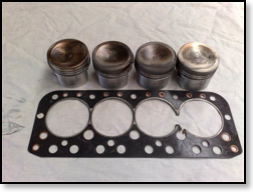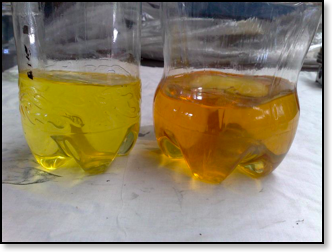That Dangers of Stale Fuel
G’day guys
We recently rebuilt a 1380cc race engine for a customer, ran it in and tuned it on a well known and reputable engine dyno, and achieved the following torque and power readings.
| revs | 4,500 | 5,000 | 5,500 | 6,000 | 6,500 | 7,000 | 7,500 |
|---|---|---|---|---|---|---|---|
| torque | 108 | 110 | 111 | 111 | 100 | 96 | 90 |
| bhp | 93 | 105 | 116 | 127 | 130 | 128 | 128 |
The engine was fitted to the car and out it went for its first race meeting. It suffered catastrophic failure after just three laps of qualifying.
A quick examination at the race circuit revealed water in cylinders 3 and 4, and no compression in these cylinders. Sounds simple – a blown head gasket.
Removal of the cylinder head revealed more serious problems. Yes, the head gasket had blown, but in addition number 2 and 3 pistons had started to melt.


Piston damage such as this is usually caused by detonation, from either:
- ignition timing too far advanced;
- lean running from incorrect carburation;
- lean running from poor fuel delivery rate; or
- poor quality or low octane fuel.
The first two possibilities were immediately eliminated. The ignition timing had been set on the dyno, the position of the distributor had been marked and it had not been moved. Likewise, the Weber jetting had been set on the dyno and the oxygen sensor in the exhaust pipe showed an ideal mixture.
We pulled the fuel hose off the Weber, and checked the fuel flow rate. This car has two fuel pumps running in parallel and pumping through a 3/8” fuel hose. It filled a one litre container with fuel in 40 seconds. That’s plenty, so fuel deliver wasn’t the problem.
But take a look at the colour of the fuel. Fresh fuel is in the container on the left, fuel from the car’s tank is on the right.

A few years ago, when I wrote the Tech Tips article No leaded fuel?, I said:
The gradual elimination of Sulphur from fuel (not well publicised) has resulted in a lower shelf life for unleaded fuel. Oil companies surveyed estimated that a half full tank of unleaded could be unusable in as little as 2 months. Sulphur used to be added as a preservative to slow down algae growth in the fuel. Without it, the algae grow and the fuel quality deteriorates. How old is the fuel in your tank now?
So yesterday, I phoned the BP Technical Support Line, and asked about the shelf life of unleaded fuel. “One month” I was told. “After one month in a half full fuel tank (ie: unsealed, plenty of air space) you would notice a drop in power. After three months, the car would be hard to start, would not idle well, and would suffer a significant loss of power. By this time, much of the high volatility elements in the fuel will have evaporated, leaving the more dense part of the mixture. In addition, the fuel will be oxidising and fungus will be growing. The fuel takes on an orange colour and gets progressively darker as time goes by.”
The fuel in the race car’s tank was eight months old. It didn’t even smell like fuel, there were quite noticeably less aromatics, and it smells more like turpentine.
Let me ask again:
How old is the fuel in your tank right now?
